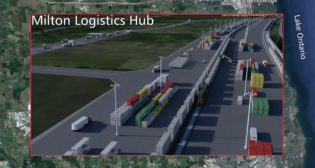
New Gensets for UP at Proviso Yard
Written by William C. Vantuono, Editor-in-ChiefThe new 2,000-horsepower Genset locomotives, RP20CDs built by RJ Corman Railpower, are powered by three 667-hp ultra-low-emission U.S. Environmental Protection Agency (EPA) off-road Tier 3-certified diesel engines that reduce NOx emissions by 80% and PM (particulate matter) by 90%, while using up to 37% less fuel compared to older switching locomotives. The fuel savings also reduces greenhouse gases up to 37%.
These locomotives differ from many Genset yard locomotives in that they are six-axle, with six traction motors, rather than four-axle. The two additional traction motors give this version of the Genset switcher increased tractive effort compared to four-axle Gensets, “something that will be useful while the new locomotives are working to push railcars over the hump, where gravity then takes the cars into destination-specific tracks at the Proviso Rail Yard,” UP said.
“We continue to voluntarily research and develop new technologies to reduce locomotive emissions and this latest version of the Union Pacific Genset locomotive is another end product of that hard work,” said Union Pacific Senior Vice President Corporate Relations Bob Turner (pictured, with Cook County (Ill.) Board President Toni Preckwinkle. “Union Pacific is committed to preserving our environment by reducing emissions to help improve air quality and conserve fuel.”
Working with National Railway Equipment Company, Union Pacific began developing a prototype Genset switcher locomotive in 2002 and today has 172 ULELs working in California, Texas, and the Chicago area. UP General Director Car and Locomotive Engineering Mike Iden led the railroad’s efforts to develop a switching locomotive that would use multiple smaller diesel/traction alternator powerplants, running in microprocessor-controlled combinations of one, two or three engines, to produce the required horsepower levels when needed. Iden’s idea was to package the diesel engine, traction alternator, and cooling system radiator in one compact, easily replaced module called a Generator Set or “Genset.”
“Modern off-road diesel engines are capable of providing the lower power required by typical switching locomotives while reducing fuel consumption and, most important, exhaust emissions,” UP noted. “Several other U.S. railroads continue to follow Union Pacific’s lead and are using similar Genset switching locomotives,” UP said. “Several Genset locomotives are also in use in Canada and South America. A railroad in Germany has ordered them as well.”
Since 2000, UP has invested approximately $6 billion to purchase more than 3,500 locomotives that meet EPA Tier 0, Tier 1, Tier 2, or Tier 3 emissions standards. Also since 2000, UP retired more than 2,650 older locomotives and overhauled or rebuilt nearly 4,150 locomotive diesel engines with emissions control upgrades. More than 80% of the railroad’s approximately 8,200 locomotives are certified under EPA Tier 0, Tier 1, Tier 2, or Tier 3 emissions standards.
UP noted that it is “constantly developing and evaluating innovative technologies. In addition to the development and implementation of Genset locomotive technology, we evaluated experimental technology, such as the Oxicat-equipped, long-haul locomotive and the DPF (diesel particulate filter) equipped, low-horsepower yard locomotive. Initial tests showed the Oxicat reduced PM by 50%, hydrocarbons by 38% and CO (carbon monoxide) by 82%. The DPF reduced PM by more than 70% in tests. We developed a comprehensive plan to reduce unnecessary locomotive idling time, and all new locomotives have automatic stop-start equipment and older locomotives are being retrofitted with it. Locomotive shutdowns can save 15-24 gallons of fuel, per locomotive, per day. More than 70% of our locomotive fleet is equipped with this technology. We assisted in the development and testing of the first five Caterpillar-Progress Rail PR30C locomotives ever built that employ urea SCR (selective catalytic reduction) to achieve Tier 4 emissions standards. We partnered with EMD to develop, test, and deploy 25 SD59MX locomotives that are relatively low emitting despite the fact they do not use urea SCR. One of these experimental locomotives is fitted with EGR (exhaust gas recirculation), DPFs, and DOCs (diesel oxidation catalysts) to achieve emissions levels well below the Tier 3 standard. We are continuing to test a ULEL Genset locomotive that has been fitted with a Johnson Mathey DPF to further reduce PM beyond its normal low level.”



